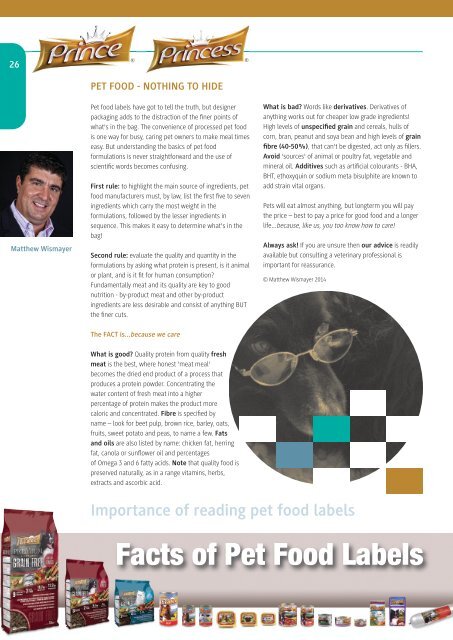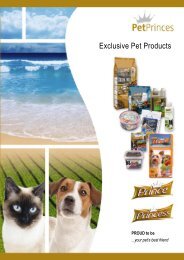Petprinces - Exclusive Pet Products
Proud to be ...... your pets best friend......
Proud to be ...... your pets best friend......
You also want an ePaper? Increase the reach of your titles
YUMPU automatically turns print PDFs into web optimized ePapers that Google loves.
26<br />
Matthew Wismayer<br />
PET FOOD - NOTHING TO HIDE<br />
<strong>Pet</strong> food labels have got to tell the truth, but designer<br />
packaging adds to the distraction of the finer points of<br />
what's in the bag. The convenience of processed pet food<br />
is one way for busy, caring pet owners to make meal times<br />
easy. But understanding the basics of pet food<br />
formulations is never straightforward and the use of<br />
scientific words becomes confusing.<br />
First rule: to highlight the main source of ingredients, pet<br />
food manufacturers must, by law, list the first five to seven<br />
ingredients which carry the most weight in the<br />
formulations, followed by the lesser ingredients in<br />
sequence. This makes it easy to determine what's in the<br />
bag!<br />
Second rule: evaluate the quality and quantity in the<br />
formulations by asking what protein is present, is it animal<br />
or plant, and is it fit for human consumption?<br />
Fundamentally meat and its quality are key to good<br />
nutrition - by-product meat and other by-product<br />
ingredients are less desirable and consist of anything BUT<br />
the finer cuts.<br />
What is bad? Words like derivatives. Derivatives of<br />
anything works out for cheaper low grade ingredients!<br />
High levels of unspecified grain and cereals, hulls of<br />
corn, bran, peanut and soya bean and high levels of grain<br />
fibre (40-50%), that can't be digested, act only as fillers.<br />
Avoid 'sources' of animal or poultry fat, vegetable and<br />
mineral oil. Additives such as artificial colourants - BHA,<br />
BHT, ethoxyquin or sodium meta bisulphite are known to<br />
add strain vital organs.<br />
<strong>Pet</strong>s will eat almost anything, but longterm you will pay<br />
the price – best to pay a price for good food and a longer<br />
life...because, like us, you too know how to care!<br />
Always ask! If you are unsure then our advice is readily<br />
available but consulting a veterinary professional is<br />
important for reassurance.<br />
© Matthew Wismayer 2014<br />
The FACT is...because we care<br />
What is good? Quality protein from quality fresh<br />
meat is the best, where honest 'meat meal'<br />
becomes the dried end product of a process that<br />
produces a protein powder. Concentrating the<br />
water content of fresh meat into a higher<br />
percentage of protein makes the product more<br />
caloric and concentrated. Fibre is specified by<br />
name – look for beet pulp, brown rice, barley, oats,<br />
fruits, sweet potato and peas, to name a few. Fats<br />
and oils are also listed by name: chicken fat, herring<br />
fat, canola or sunflower oil and percentages<br />
of Omega 3 and 6 fatty acids. Note that quality food is<br />
preserved naturally, as in a range vitamins, herbs,<br />
extracts and ascorbic acid.<br />
Importance of reading pet food labels<br />
Facts of <strong>Pet</strong> Food Labels



